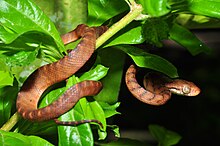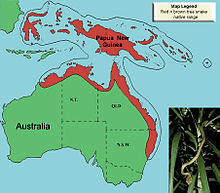
Back بويقة شاذة Arabic بويقه شاذه ARZ Boiga irregularis Catalan Boiga irregularis CEB Bojga hnědá Czech Braune Nachtbaumnatter German Boiga irregularis Spanish Boiga irregularis EU مار درختی قهوهای FA Ruskopuukäärme Finnish
| Brown tree snake | |
|---|---|

| |
| Scientific classification | |
| Domain: | Eukaryota |
| Kingdom: | Animalia |
| Phylum: | Chordata |
| Class: | Reptilia |
| Order: | Squamata |
| Suborder: | Serpentes |
| Family: | Colubridae |
| Genus: | Boiga |
| Species: | B. irregularis
|
| Binomial name | |
| Boiga irregularis (Merrem, 1802)
| |

| |
| Synonyms | |
|
Coluber irregularis Merrem, 1802 | |
The brown tree snake (Boiga irregularis), also known as the brown catsnake, is an arboreal rear-fanged colubrid snake native to eastern and northern coastal Australia, eastern Indonesia (Sulawesi to Papua), Papua New Guinea, and many islands in northwestern Melanesia. The snake is slender, in order to facilitate climbing, and can reach up to 2 meters in length. Its coloration may also vary, some being brown, green, or even red. Brown tree snakes prey on many things, ranging from invertebrates to birds, and even some smaller mammals. It is one of the very few colubrids found in Australia, where elapids are more common. Due to an accidental introduction after the events of World War II, this snake is now infamous for being an invasive species responsible for extirpating the majority of the native bird population in Guam.[2] Currently, efforts are being made to reduce and control the population on Guam and prevent the snake from spreading to other locations.
- ^ Allison, A.; Tallowin, O.; O'Shea, M.; Parker, F.; Greenlees, M.; Wilson, S. (2018). "Boiga irregularis". IUCN Red List of Threatened Species. 2018: e.T196562A2460107. doi:10.2305/IUCN.UK.2018-1.RLTS.T196562A2460107.en. Retrieved 19 October 2023.
- ^ Fritts, T.H.; D. Leasman-Tanner (2001). "The Brown Treesnake on Guam: How the arrival of one invasive species damaged the ecology, commerce, electrical systems, and human health on Guam: A comprehensive information source". U.S. Department of the Interior. Retrieved 2008-09-11.
